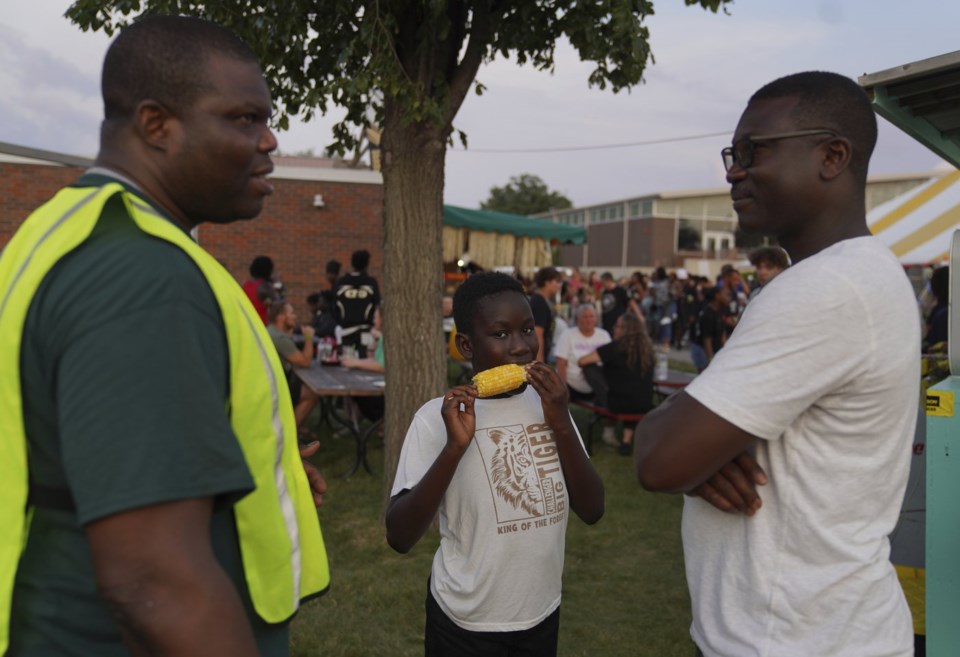CEDAR RAPIDS, Iowa (AP) — It was in Cedar Rapids, surrounded by cornfields, where Iowa artist Grant Wood painted “American Gothic,” the iconic 1930 portrayal of a stern-looking woman and a man with a pitchfork in front of a white frame house.
The city presents many different images today, after more than a century of international migration and faith-based resettlement efforts.
To many newcomers as well as lifelong residents, this heartland river city where migrants from present-day Lebanon built the oldest surviving mosque in the U.S. is a welcoming microcosm of America’s melting pot at a time when immigration enforcement is disrupting families and communities.
Hundreds of refugee families were resettled by The Catherine McAuley Center, founded by the Catholic Sisters of Mercy, until the nationwide halt ordered by the Trump administration this spring. At a recent class offered by the center, a Guatemalan woman and her son, along with five men from China, Benin, Togo, Sudan and Congo, sang the U.S. national anthem and rehearsed questions for the citizenship test.
“It is a matter of meshing or integrating — how do we get around in the community? How do we find our friends? How do we find bridges across cultural divides?” said Anne Dugger, the center’s director.
As Americans struggle to redefine who belongs in the social fabric, these are snapshots of heartland immigrants and their faith communities.
The story begins: Bohemians in Iowa
Bob Kazimour goes to Mass at St. Wenceslaus, where he remembers as a child the liturgy was in Latin and the homily in Czech. It’s the language of generations of his ancestors who left what was then Bohemia in Central Europe to work in Cedar Rapids’ meatpacking plants, forming the area’s first large immigrant group in the mid to late 1800s.
Kazimour can still sing a few Czech carols — and there’s a Czech choir, a Czech school and a goulash festival to commemorate.
He and other parishioners whose great-great-grandparents went to St. Wenceslaus aren’t certain new generations will keep up Czech customs. But the Catholic parish is growing again after merging with Immaculate Conception, a downtown church with a booming Latin American congregation.
“In Cedar Rapids, unlike the coasts with lots of problems, we’re Iowa nice. We get along pretty darn well,” Kazimour said.
A heartland Muslim community still grows
At the beginning of the 20th century, Lebanese Muslims came to the Midwest, often starting as itinerant merchants before establishing grocery stores. In a few decades, Cedar Rapids had dozens of these businesses — and a mosque.
Within ten months after Mohamed Mahmoud came to the United States from Sudan in 2022, he opened a halal grocery store in a strip mall a few minutes drive from the Islamic Center of Cedar Rapids, where he prays on Fridays.
“Religion is a part of life wherever you go. If you don’t find a mosque, it’s something missing,” he said in-between serving sweets at a counter with Muslim holiday decorations and American flags. “Cedar Rapids is the best option for me to live the rest of my life.”
African touches to the sweet corn festival
A few blocks from Mahmoud’s shop, the St. Jude Catholic Church’s Sweet Corn Festival was in full swing. And among the many volunteers sporting 50-year-anniversary festival T-shirts were members of the growing African congregation, mostly from Togo and Congo.
While frying funnel cakes and Snickers bars, Bienvenue D’Almeida described a journey shared by many of St. Jude’s parishioners. Wanting better educational opportunities for their children, they applied for and won the so-called green card lottery, a program for countries with low rates of emigration to the United States.
At St. Jude, the migrants found aid on arrival, and soon built French-speaking ministries, from family groups to choir to monthly French Mass.
“You feel safe, and because of that, you’ve that sense of belonging,” said Roger Atchou, a father of two from Togo and festival volunteer.
“For us, St. Jude represents the United States — it’s open to everyone,” said parish council member Martin Mutombo, a Congolese volunteering with his wife, Clarisse, and five children.
“We feel very comfortable” in this adopted homeland, Clarisse Mutombo said. Nevertheless, they're painfully aware that others in the congregation are having a harder time, including a father detained for overstaying a visa.
Methodist Sunday service in Kirundi
Another African refugee congregation gathers in the historic St. Paul’s United Methodist Church for Sunday afternoon services in Kirundi, one of Burundi's languages.
“When I work here for God at St. Paul’s, I have a peace. I find myself home,” said the Rev. Daniel Niyonzima, through his son’s translation.
The pastor and his wife, from Burundi, arrived nearly 20 years ago after more than a decade in refugee camps in Tanzania, and were hosted by the Methodist congregation. Now they’re U.S. citizens — and grandparents.
Across the hall from the sanctuary, English classes and driver’s ed are hosted by a nonprofit started by a church member, Mugisha Gloire, a Congolese refugee who came as a child to Iowa. He remembers how warmly he was welcomed by a local volunteer who took him to swimming lessons and baseball games.
“Cedar Rapids has a long way to go to welcome everyone, but there are also some very great people,” Gloire said.
A growing flock from south of the border
A few blocks west of St. Paul’s is Immaculate Conception Catholic Church, where five children were baptized recently at the Spanish-language Mass that’s been held regularly for more than a dozen years.
Holding her newly christened 4-month-old nephew Gael, Gabriela Plasencia, originally from the Mexican state of Jalisco, said receiving the sacraments in Spanish allows them to “live them differently, understand more deeply.”
Being able to worship in their native language is a special blessing as the immigration crackdown casts a pall, some parishioners said. Many know people in the country illegally who have left voluntarily, and others who were arrested and deported. Everyone feels affected, said Gabriela's father, David Plasencia.
“Inside here, we feel pretty peaceful, but the moment we go out into the streets, we all feel that anxiety,” he said.
___
Associated Press religion coverage receives support through the AP’s collaboration with The Conversation US, with funding from Lilly Endowment Inc. The AP is solely responsible for this content.
Giovanna Dell'orto, The Associated Press




